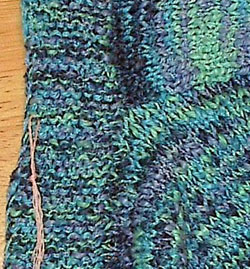 |
| The grafted
seam that started the whole ‘what
makes an advanced knitter?' thought process.
If you can't find it, the pink string
marks it. It's a zombie knitting project.
|
I recently had occasion
to graft a seam in garter stitch. After the
third try, when I had it right, I was admiring
it and suddenly thought: "I wonder if beginner
knitters think we already know this stuff?"
I've been knitting nearly twenty years now,
and I don't think anyone argues about whether
I'm considered "advanced", and yet
I'd never needed to graft a seam in garter
stitch before. When I did, I sat down and
figured out how to do it.
Do beginner knitters
have this idea that advanced knitters have
a great, mystical overview of the art? Are
we supposed to know everything?
Because let me tell
ya. We don't.
As far as I can tell,
the only difference between "beginner"
and "advanced" is that advanced
knitters have a more devil-may-care attitude
toward trying new things. In trying new things,
we learn new stuff. Funny how that works.
So the knitting maniacs of the world move
on to advanced status, cavalierly adding pockets
where we want, knitting gloves and socks,
putting swathes of color all over, and otherwise
biting off more than we can chew and figuring
it out as we go. I'm sure this says something
about the personality of some knitters. I'm
not sure it's good, but there it is. Some
of us are just nuts and will try anything
once. We're shameless. A lot of us probably
bungee jump and get into bar fights, too.
Some beginner knitters
are more than content to make scarves and
simple sweaters, and to you I say keep right
on. The whole point of this exercise is to
enjoy ourselves, and if you are, then you're
doing it right. But for those of you who want
to expand, experiment, or have an urge to
bungee jump, you've come to the right article.
I learned to knit
in the Dark Ages. (That would be the 1980s.)
At the time, it was nearly impossible to find
a good local yarn shop and the internet didn't
exist to help locate national catalogue suppliers.
You were stuck with what you could find at
KMart, or paying truly obscene amounts of
money for average yarn. At the time, I didn't
know anyone else who knit, and so I had no
one to tell me anything was difficult. After
hitting the local library, I found some old
lace patterns, got some #10 crochet cotton
and size two double-point needles, and started
figuring out how to knit lace medallions.
And that's what I did for 10 years.
Boring? Less than
you'd think. Although I did occasionally wish
I could knit something to wear< . But you
know what? Once I finally found a source for
decent yarn (thank you, Patternworks) and
I sat down to knit myself a sweater…well,
shoot, those sweater patterns looked downright
easy!
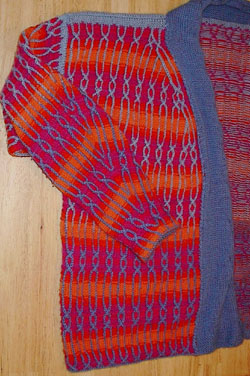 |
| The first
of my off road knitting projects, adapted
from Elizabeth Zimmermann's Chain Mail
pullover. This is the first color knitting
I ever did. Check out the neck and sleeve
decreasing. |
After a few perfectly
executed but bland solid-color sweaters, I
started eyeing Fair Isle sweaters and drooling.
All those colors. Mmmm. I love color. Yet
all the patterns I saw were for yarns that
were either too expensive or impossible to
find. Well, no worries, I thought, all cocky,
I would just make up my own pattern! Unwilling
to go completely off road, I adapted the "Chain
Mail" sweater in Elizabeth Zimmermann's Knitter's
Almanac . It turned out surprisingly well.
(Now that I know better, I'm amazed at how
well it turned out, actually.)
My
point to all this is, I had no freaking idea
what I was doing when I started lace or color
work, but I came out the other side
with some decent projects and a lot of knowledge.
You too can do this, Grasshopper. Just a few
things to keep in mind:
1. It doesn't have
to be expensive.
For crying out loud, no matter what you do,
keep the cost of a learning project as low
as possible. Nothing will make you choke faster
than knowing you're in the process of destroying
$500 worth of cashmere. I once made up a simple
pattern for some 100% silk roving yarn and
nearly had a nervous
breakdown-- and that was after I knew what
I was doing. If you see something new and
exciting and you have
< to knit it, fine. Knit something similar
first, so you can learn the skills. Then blow
the big bucks. This is one reason I suggest
fooling around with lace medallion knitting
[see below]. Even if you never finish the
thing, you're only out a spool or two of thread.
They run about $2.50 each. This is no big
deal. Brown Sheep makes affordable wool yarn,
and Reynolds makes some nice cotton and lopi,
also reasonably priced. Take advantage of
it. Or knit a miniature version of the project
you want to do, and make a kid you know very
happy.
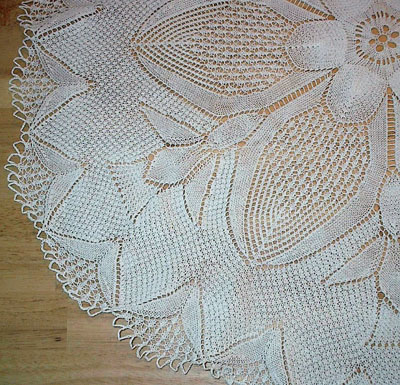 |
| The only
lace medallion that I ever kept. The
pattern is available in The Second Book
of Modern Lace Knitting . There's nothing
in this pattern but knit, decrease,
increase, and yarn over. But you might
want to start with something smaller.
|
2.
Knit some lace.
Most of you are shuddering now, but I'll tell
you what. Knit a couple medallions, and you'll
be able to handle anything you ever meet in
a pattern, ever again, except color knitting.
Cables? Weird decreases? Double points? Fine
gauge? You will laugh in the face of it all.
(After all that medallion knitting, I actually
prefer very fine gauges for sweaters and other
projects-- small stitches mean nearly invisible
mistakes.)
Amazon.com has The
First Book of Modern Lace Knitting and The
Second Book of Modern Lace Knitting, both
by Marianne Kinzel, available for around ten
bucks each. These are great books because
you get two versions of each pattern-- one
written out and one charted. If you can't
read charts, you can teach yourself that,
too. There are directions in the front for
specialized cast ons and bind offs.
3. Pick something
cool.
Particularly for color knitting, which can
be pretty involved, pick something that you
think is the coolest damn thing you ever saw.
You're going to be looking at it for a while.
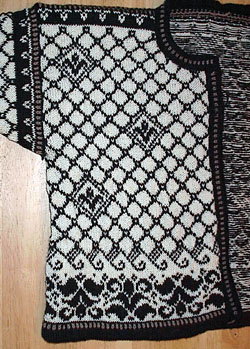 |
| The ubiquitous
Dale Cardigan. Those steeks are crocheted.
Learn something new every day. |
4. Keep two projects
going at once.
Not literally at once, but have two to choose
from. I call mine "The Epic" and "Zombie Knitting".
Epic projects usually involve color (the one
I'm doing now has twelve), weird shaping,
lace, cables, or something I've never done
before. It's a challenge and you have to pay
attention to it. Zombie knitting means standard,
one-color, stockinette projects like sweatshirts
and other things I do really, really well.
This way, when I get frustrated or stalled
with an Epic, I can take a Zombie project
to the movies with me and zone out. And feel
like I'm accomplishing something. I finish
one or two Epics and eight to ten Zombies
every year. That's another reason for two
projects-- learning isn't always a quick thing.
5. Quit shooting
yourself in the foot.
Do not look at
projects and say "I couldn't do that."
Look at them and say "How did they do
that?" People look at lace knitting and
freak out. Know what? All it is is knitting,
purling, decreasing, and yarn overs. Whoopee.
Anyone can do that. Same with stranded
color knitting; you carry two yarns and
knit with the color you want. It's knitting,
for crying out loud, not brain surgery.
Quit spazzing, get some needles, and try
it.
6.
Know you're going to get better.
When you finish
a project and look at it, thinking, "I wish
I'd done the sleeve caps differently, and
fixed the collar, and added pockets, and..."
this does not< mean you failed. It means you
learned something. While knitting a Dale of
Norway kit a year ago, I encountered Meg Swansen's
crocheted steek (see Knitting from Camp or
Meg Swansen's Knitting-- the crocheted steek
is the coolest thing since chocolate). And
now I wish I could go back and fix the un-crocheted
steeks in everything I ever knit. But my other
sweaters aren't failures or bad; it just means
my next ones will be even better. This is
cause for celebration, people.
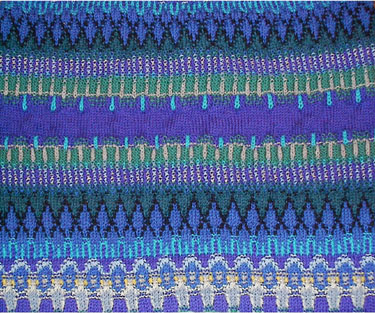 |
| Detail from
the current Epic Knitting project, as
yet unfinished. The education goes on.
And on. And on. |
7. It's okay to
hate something.
I can do intarsia knitting, but I hate it.
And I hate all these new novelty yarns; the
weight of them bothers my hands and I go blind
trying to figure out where the stitches are
in all that fuzz. My answer to this is to
not do intarsia or use novelty yarns. But
the point here is I tried it first and then
decided I didn't like it. It's like broccoli.
Give it a try before you decide you can't
or won't do it.
If there's something
you've always wanted to try, please, go try
it. None of these skills are difficult, just
slightly different from each other. All it
really takes is sitting down and figuring
it out. If you can knit at all, you can learn
the rest of these skills. No knitter ever
had a revelation from on high; we all had
to sit down, knit, rip, knit, rip, and figure
it out for ourselves. There's not a thing
in the world stopping you from doing it too.
So go! Cast on something you thought was too
hard for you! It's safer than bungee jumping.
And when people
ask you if you're an advanced knitter, you say, "Why,
no. I'm a maniac." |

